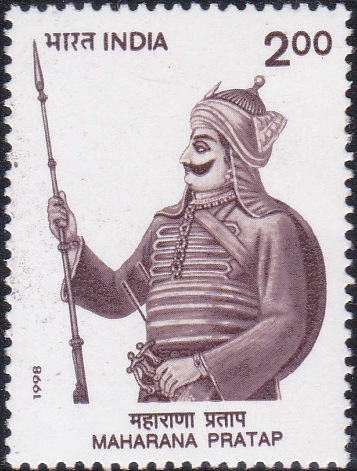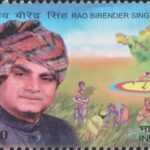
Sardar Pratap Singh Kairon
A commemorative postage stamp on Partap Singh Kairon, 3rd Chief Minister of Punjab (1956-64) :
Issued on Oct 1, 2005
Issued for : The Department of Posts is proud to issue a commemorative postage stamp in honour of Sardar Pratap Singh Kairon.
Type : Block of 4 Stamps, Mint Condition
Colour : Multicolour
Denomination : 500 Paise
Print Quantity : 0.6 Million
Printing Process : Photogravure
Printer : India Security Press, Nashik
Name : Partap Singh Kairon
Born on 1901 at Kairon, Amritsar district, Punjab, British India
Died on Feb 6, 1965 at main highway (the G.T. Road) from Delhi to Amritsar
About :
- Sardar Pratap Singh Kairon is generally acknowledged as the architect of modern Punjab. A colourful figure who dominated the political life of Punjab in his time, he combined a vision for the future with a rare will and determination to usher in the changes needed to shape a prosperous and progressive Punjab in the post-independence era.
- Born on 1st October 1901, in the village of Kairon in Amritsar district of Punjab, into a farming family of modest means, his father Nihal Singh was also a pioneer of women’s education. While still a student of the Khalsa College at Amritsar, Pratap Singh Kairon left home for the United States of America. There he had to earn his way by working on farms and in factories, while also concerning himself with the problems back home, and working with groups determined to advance independence for India. He eventually took a Master’s Degree in Political Science from the University of Michigan. Influenced by the American way of life he also came to believe that affluence on farms was within the reach of the Punjabi villagers.
- Returning to India in 1929, Pratap Singh Kairon started a progressively weekly paper in English “The New Era”, the first issue of which appeared on 13th April 1931. Soon thereafter he entered active politics and joined the Shiromani Akali Dal, a party of Sikh activists. As the Indian National Congress and the Shiromani Akali Dal then worked together, he became General Secretary, and later President, of the Punjab Provincial Congress. Later on, when the Congress and the Akalis parted ways, Pratap Singh Kairon stayed on with the Congress. In 1932 he participated in the Civil Disobedience Movement and was imprisoned for five years. In 1938, he was imprisoned again, this time for leading the Kisan Agitation against “Abiana”. He was also imprisoned during the 1942 “Quit India” movement.
- Pratap Singh Kairon was elected to the Punjab Legislative Assembly in 1936, and again in 1946. In 1946 he also became a member of the All India Congress Committee, as also a member of the Indian Constituent Assembly. Inducted into the Punjab Cabinet in 1947, he became Minister for Rehabilitation in 1948, and was faced with the challenging task of resettling millions of refugees who had poured into Punjab from Pakistan. Instead of giving them doles, he gave them land to work upon and financial loans, thus encouraging employment and productivity. In 1956 he became the Chief Minister of Punjab and remained so till 1964. While working for the all round development and prosperity of Punjab, he was able to handle many sensitive issues with rare courage and resolve. During the national emergency, caused by the Chinese aggression on India in October 1962, Punjab under his leadership played a leading role in the defence of the nation, whether by way of collection of defence funds or by way of raising recruits for the army as well as the home guards.
- Pratap Singh Kairon was convinced that no real progress could be achieved without education. So he made primary and middle school education free and compulsory. He also gave a boost to technical education. While this was made free upto the school standard, he opened three engineering colleges, a polytechnic in each district, and a number of industrial engineering institutions. He also established the Kurukheshtra University, Karnal, the Punjab University, Patiala and the Punjab Agriculture University, Ludhiana, apart from four medical colleges, as well the Post Graduate Institute at Chandigarh, which is one of the biggest and best Medical Research Institutes in India.
- While striving to organize agriculture, dairy, and poultry farming on modern scientific lines, Pratap Singh Kairon also worked to place Punjab on the industrial map of the country. Under his stewardship Punjab attained an enviable position in the country’s small scale industry sector. The industrial township of Faridabad, and the planned garden city of Chandigarh were both his brainchild. He also gave special attention to the development of infrastructure like roads, power, and irrigation, etc. which are so necessary for progress and development.
- On 6th February, 1965, Sardar Pratap Singh Kairon was assassinated near village Rasoi on the National Highway while travelling in a car back to Chandigarh from Delhi. But his abiding legacy lives on.
- Text : Based on material given by the proponents.


![2136 Pratap Singh Kairon [India Stamp 2005] Block of 4](https://istampgallery.com/wp-content/uploads/2015/09/2136-Pratap-Singh-Kairon-India-Stamp-2005-Block-of-4.jpg)






[…] Medical Education and Research (PGIMER), Chandigarh owes its inception to the farsightedness of Pratap Singh Kairon, the then Chief Minister of the combined state of Punjab in 1960. The institute was formally […]